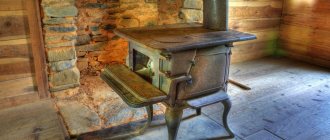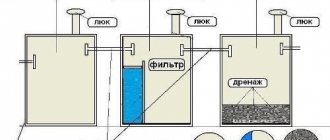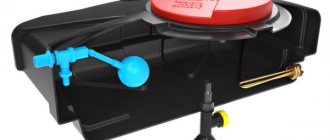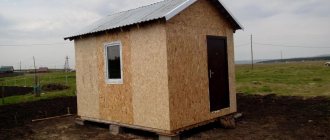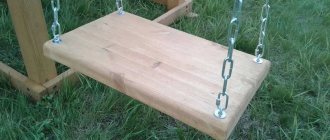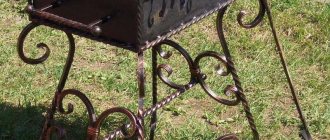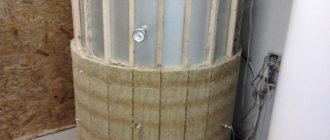Normal operation of the ventilation system requires the presence of draft in the channels and air ducts. But over time, debris can get into the mine; the channels can simply become clogged with dust, which sticks tightly to their walls, especially if they have a greasy coating. All this reduces the diameter of the air ducts, which negatively affects the operation of the entire ventilation system.
That is why many homeowners install special devices called deflectors on the heads of ventilation pipes.
How to make a ventilation deflector with your own hands - from drawing to finished device
Normal operation of the ventilation system requires the presence of draft in the channels and air ducts.
But over time, debris can get into the mine; the channels can simply become clogged with dust, which sticks tightly to their walls, especially if they have a greasy coating. All this reduces the diameter of the air ducts, which negatively affects the operation of the entire ventilation system. That is why many homeowners install special devices called deflectors on the heads of ventilation pipes.
Ventilation schemes
When sewer ventilation is planned when designing a house, it is most often done inside the house. In this case, the riser is brought to the roof in the form of a fan pipe. She seems to be his natural continuation. The diameter of both pipes must match (if the riser is 110 mm, then the drain pipe is 110 mm). The ventilation duct is designed in such a way that the vent pipe is located away from the windows (at least 4 meters) in order to timely and naturally eliminate unpleasant odors.
The elevation of the vent pipe above the roof depends on the type of roof and varies from 0.2 to 3 meters. Its height is regulated by the set of rules SP 30.13330.2012. For example, for a flat roof of a country house, at least 300 mm of elevation is required, and for a pitched roof - about 500 mm. The ventilation is equipped with a deflector on top, which serves as protection for the sewer system from the penetration of precipitation and to enhance air draft. In general, the deflector increases the efficiency of the ventilation system in the house.
Experts do not recommend connecting the ventilation riser to the pipes of a chimney or a general house exhaust system. But it can combine approaches from several sewer risers. When the vent pipe is installed sideways (into the wall), it is not placed under the roof overhang, since there is a great danger in winter that the outlet will be disrupted by a mass of snow or ice. It is also recommended to hide the exit hole behind a decorative rosette.
Features of the device
This is a description of the operating principle of all deflectors, of which there are a huge number of designs. Many devices not only deflect air flows, but also increase the speed of their passage over the head of the ventilation pipe by narrowing the channel, thereby significantly increasing draft (airbrush principle).
Proper use of the deflector helps increase the productivity of the entire ventilation system by up to 20%; it is especially useful on ventilation ducts with large horizontal sections and bends.
In addition, the deflector on the ventilation pipe perfectly protects against the entry of various debris, small birds, insects, and most importantly, precipitation. Basically, the material from which these devices are made is resistant to corrosion. This is galvanized or stainless steel, ceramics or plastic.
Ventilation exit through the roof
It is not recommended to leave the sewer vent outlet in the attic as it is not properly ventilated and the odor can penetrate into the house. The pipe must be pulled through the roof. The work is performed in the following sequence:
- the installation of the exhaust pipe is completed in the attic;
- the end section of the pipe is fixed to the roof surface;
- Using a corrugated adapter, two sections of pipe are connected.
The end section of the pipe is fixed to the roof surface using a flexible and elastic adapter made of polymer material. Its cuff is sealed and securely fastened with screws or other fasteners. It is easiest and most reliable to use a factory-made ventilation outlet designed for a specific type of roof for installation on the roof.
Under normal conditions, the warm air that comes out of the ventilation duct prevents the sewer ventilation outlet from freezing. Note that in regions where the temperature in winter can drop below thirty degrees, ice freezes and the ventilation outlet becomes clogged. In this case, thermal insulation of both the ventilation duct section in the attic of the building and its outlet on the roof is necessary.
Existing types of deflectors
Today there are a huge number of different designs of such devices. Among them, the most popular models are:
- TsAGI is an effective and simple design wind redirection device.
- Grigorovich is also a very popular deflector design.
- H-shaped device for effectively increasing draft in ventilation and chimneys.
In addition, various designs of open deflectors are often used both on the heads of ventilation and chimney pipes.
- According to the shape of the top of the device.
- Rotating (rotary or turbine).
- Deflectors-vanes.
In addition to such a common material as metal, these devices are made of plastic. The plastic ventilation deflector is less durable than its steel counterpart, but has a lower cost and a more sophisticated appearance.
That is why plastic devices decorate the ventilation shafts of most private houses. But besides its service life, it has another serious drawback. Plastic does not withstand high temperatures, so it is not recommended to use it on chimneys.
Weather vanes - deflectors are usually installed on chimneys, but they are also quite suitable for ventilation systems. The air flow, passing through a system of visors and slots in the product body, is redirected due to which a low pressure zone is created above the pipe. It should be recalled that the weather vane has a design that allows this device to be constantly turned, with the working side facing the wind.
Due to its design, the rotating ventilation deflector not only increases draft in the ventilation shaft, but also effectively protects it from various debris and insects. This device, as a rule, has a spherical shape, so it stands out among all with its original design.
There is another original type of ventilation deflector - rotary, or as it is also called turbine. This device converts the energy of air flows into the rotational movement of a turbine, which spins the air according to the principle of a tornado, thereby creating an increase in draft in the air duct. This device shows excellent results even in the warm season, creating draft in the ventilation system.
Options for installing an external ventilation system
If the design documentation of the house does not provide for a sewer exhaust system, after putting it into operation it is necessary to install an external ventilation system. The pipe connected to the drain is brought outside and mounted in a place convenient for its location. One option for placing a ventilation pipe is to strengthen it on the external wall of the house. The connection is made not to the riser, as with internal ventilation, but directly to the wastewater drain.
The external exhaust pipe can be mounted on a fence, wall of an outbuilding or other vertical surfaces. With this installation option, you must keep in mind that disgusting-smelling miasma is released near the outlet, and position the exhaust pipe in such a way that the bad smell does not create inconvenience to neighbors in the area.
For owners of country houses, the simplest and at the same time effective installation option is to install an exhaust pipe directly into the fecal pit.
It is always located away from residential premises, so the bad smell will not bother household members. The height of the pipe above the ground may not exceed one meter.
Often, owners of small houses doubt that sewer ventilation is advisable, assuming that it will not function in the hot season during the period of especially intense decomposition of organic matter. These doubts have no basis, since the temperature of the wastewater will always differ from the ambient temperature, as a result of which a pressure difference arises, and air and heat exchange will occur.
A properly installed drain pipe ensures comfortable living by preventing the foul smell of sewage from appearing in living areas. Probably, the owners of private houses can be creative and come up with a hood of their own design. The main criterion is that she cope with the tasks assigned to her, and the household does not complain about the author of the project. The following is a video that provides useful information about installing a fan riser.
Any person living in a private household has at least once encountered a problem when, during strong winds or hot weather, “amber” from the sewer penetrated into the home. Gases formed as a result of the decomposition of organic matter smell unpleasant. In addition, you are probably familiar with sewer gurgling and “slurping” sounds when draining wastewater. This occurs due to changes in pressure in the sewer system and the formation of vacuum plugs. All these troubles are eliminated in a private home.
Ventilation is necessary for any type of sewage system: centralized, autonomous, isolated or non-insulated. It will not only provide the required volume of fresh air, but will also balance the pressure of the system, due to which the wastewater will drain silently. The sewer hood should ideally be designed during construction in a private house
In practice, it happens that attention is paid to its arrangement only when guests make a comment about the fragrant, persistent aroma in the room or area
Making a simple device with your own hands
Despite the complexity of the design, every home craftsman can make a deflector with his own hands. You just need to have the necessary tools and materials. To make this device yourself you will need:
- A sheet of thick paper or cardboard.
- Galvanized metal sheet.
- Drawing of a deflector with calculations regarding the diameter of the pipe.
- Rivet gun.
- Metal scissors.
- Drill with a set of drills.
- Marker or scriber.
After preparing the tools, material and personal protective equipment (goggles, gloves), you can begin making a ventilation deflector with your own hands.
- First of all, you should transfer the contours of the product from the drawing to the metal. There must be scans of all the main parts of the device: cap, diffuser, outer cylinder, racks.
- After this, you need to cut out all parts of the device according to the resulting pattern.
- Connect all parts of the device, according to the drawing or sketch, using a rivet gun.
- Connect the two parts of the deflector using stands cut from the same metal.
After manufacturing, you can install the deflector on the head of the pipe, carefully securing it with clamps.
Tip: The deflector will create additional draft in the channels only if all its parts are made to certain dimensions. It should be remembered that the installation should be carried out while working at height, so it is better to do it together and with insurance. If you are not confident in your abilities, contact professionals who have experience in the manufacture and installation of these necessary devices.
Is ventilation of internal sewerage necessary?
Existing building codes and regulations make it possible not to install ventilation in the internal sewerage of houses with a small volume of wastewater discharge. In this case, the height of the building should not exceed two floors. In the case when the total volume of wastewater exceeds the diameter of the receiving sewer pipe, ventilation is required even in a one-story house.
As an example, imagine that the toilet drain pipe has a cross-section of eight centimeters, and the riser has a cross-section of twelve centimeters. If you flush water from one toilet, the riser will not block the flow of liquid, but if you flush two toilets at the same time, the sewer will overflow. Thus, it is possible to foresee the likely discharge of wastewater by possible plumbing fixtures and understand whether it is necessary to equip an internal sewerage hood. It is necessary in the following cases:
- if the cross-section of the riser is less than or equal to five centimeters;
- toilets and sinks are located on all floors of a building two or more stories high;
- the house has a large bathtub;
- There is an artificial reservoir in the form of a pond or swimming pool on the site.
The cause of an unpleasant odor can also be drying out of water in the siphon water seals.
These elements are designed with curved tubes that must always be filled with water to prevent sewer gases from escaping. If there is no water in the water seal, the living quarters of a private house are filled with miasma.
If such a problem occurs when residents are absent for a long time, to prevent the spread of odor from the sewer, you need to pour a little vegetable oil into the appropriate drain hole. Then the water in the water seal will not dry out, and the problem will not arise.
DIY turbo deflector
To ensure good draft in the chimney, it is necessary to install a structure that can increase the rate of removal of combustion products from the smoke duct. Therefore, if you own a house or an extension with stove heating or a ventilation shaft, then you need a turbo deflector. With its help, you can not only increase draft, but also protect the chimney from the penetration of carbon monoxide, debris or precipitation, and also prevent the occurrence of the reverse draft effect. The cost of such a device is quite high. However, you can save money by making a turbo deflector with your own hands, using available materials and tools.
Next, we will tell you how to make a deflector yourself, and how to install rotary turbines on a chimney.
Problems to be solved
A septic tank is a kind of drainage collector into which, through a drainage riser, comes everything that we try to get rid of in the toilet, kitchen, etc. The water passed through it is then directed through a drainage outlet either into a ditch or into filtration fields. This is a continuous process, because it’s rare that we don’t use the toilet, shower, etc. For the drainage mechanism to “work like a clock,” the ventilation of the cesspool must be well established. It must be done in such a way that at least two tasks are successfully solved:
- No “leakage” of unpleasant odor into rooms where it is not expected at all (toilet, bathroom, kitchen, etc.).
- Ensuring continuous and high-quality waste disposal through the septic tank.
The last condition predetermines the success of the actions of bacteria living in the drain collector. After all, it is they who perform the function of processing the mass of waste, decomposing it into gases, purified water and sludge. They operate in two groups:
- anaerobic, capable of producing methane from what enters through the drain into the thickness of the slurry of the 1st chamber of the septic tank (household waste of various origins);
- aerobic, “eating up” from the surface of the liquid what is left after the first group, and releasing hydrogen sulfide.
Construction of a two-chamber septic tank
In addition to these gases, other volatile compounds (phosphorus, arsenic, etc.) are also present in the “exhaust”. What could this lead to? If ventilation is not provided in such a gas-filled volume or is not made effective enough, then the products produced by bacteria will begin to flow through the sewer back into the house (toilet, bathroom, kitchen, etc.). In a favorable case, this will lead to a pervasive atmosphere of stench, and in a less fortunate case, it will lead to an explosion, quite possible due to the presence of methane.
Types of deflectors
There are several types of deflectors. They differ from each other in shape and number of parts. At the same time, you can choose the materials that are used to create them to your taste. It could be:
- Copper
- Cink Steel
- Stainless steel
Their shape can be very diverse: from cylindrical to round. The upper part of the deflector structure may have a cone-shaped umbrella or a gable roof. The device can also be equipped with various decorative elements, for example, a weather vane.
Let's take a closer look at several varieties:
A structure whose parts are connected by flange or other means. This device is made from stainless steel, less often from galvanized steel. Its feature is its cylindrical shape.
Its shape resembles the TsAGI deflector, but its main difference is the upper part. This device is most often installed on chimneys in small extensions, for example, in bathhouses.
If the site is located in an area with low winds, then such a device will provide excellent traction for many years. Experts call it a modified version of the TsAGI deflector.
This type of device is distinguished by its simplicity and efficiency. This open-type deflector is made of galvanized or stainless steel, which improves traction efficiency in any wind direction.
- H-shaped deflector
Its design is particularly reliable, since the deflector is made of stainless steel, and all parts are connected using the flange method. It can be installed in areas with any wind direction.
This version of the device is the most popular and widespread. It has a rotating body on which a small weather vane is attached. The construction is made from stainless steel.
This device allows for maximum protection of the channel from clogging with debris and precipitation. Rotation occurs in one direction only. It is worth noting that it is necessary to monitor its condition, since in case of icing, as well as in calm conditions, the deflector will not work. Therefore, many people install it on gas boilers. It is also used as a rotary turbine, which is necessary for ventilation of residential and office spaces.
In addition, there is a Khanzhonkov deflector. However, it is currently not used, since more modified models of devices can be found on the market.
Is ventilation necessary in a septic tank?
The range of sealed containers for processing household wastewater is huge: in addition to various industrial models, from a simple storage tank to a biological water treatment plant, there are many homemade types made of concrete, brick and plastic.
One of the options for installing a three-chamber septic tank
The most effective structures consist of 2-3 parts:
- in the first, sewage settles with sedimentation and fat floating;
- in the second - additional purification of the already clarified liquid;
- in the third – final filtration.
Factory models are initially equipped with equipment that ensures air movement. The fact is that the main mission in cleaning processes is performed by bacteria. It is their work that determines the characteristics of purified water, as well as the ability to use it in the future (for washing a car, watering a garden, etc.). Some bacteria - aerobic - cannot process biological waste without the presence of oxygen. Therefore, it is necessary to ensure air flow. Compounds of various chemical elements, including oxygen, form gases with an unpleasant odor. Some of them (for example, methane) are dangerous to people and animals.
Ventilation outlet in a concrete septic tank
Homemade devices made according to the simplest schemes are most often ventilated naturally - through hatch cracks or a gap in sewer pipes. What does this lead to? Firstly, to the spread of unpleasant “exhausts” from under the manhole cover, and secondly, to the appearance of the same specific smell inside the building. Poisonous gases entering a residential building signal that it is unsuitable for habitation.
It turns out that the correct ventilation of a septic tank in a private house solves two important problems: it increases the efficiency of the treatment plant and eliminates the danger of poisoning with harmful gases. There are several ways to arrange hoods:
- installation of pipes that allow air to enter the tank and return out of it;
- use of a set of vertical risers for air flow on the drainage field;
- installation of a vent pipe inside the building.
The safest is the integrated use of all methods, however, for a small dacha operating only in the summer, one is enough.
Diagram of the ventilated chamber
Principle of operation
A classic deflector consists of several parts:
- cylinder
- diffuser
- an umbrella that protects the chimney from the penetration of debris and precipitation
- ring bumpers that are mounted at the bottom of the device and around it
The device is installed on the chimney, which allows it to create an obstruction to the air flow. Thus, the wind is broken up into a huge number of small air currents that have very low intensity. This is necessary so that the wind flow captures the smoke that comes out of the smoke channel, which allows for increased draft. In addition, the deflector prevents the shock gas coming out of the pipe from entering back.
As experts note, if the chimney is incorrectly positioned on site, the deflector cannot operate at full capacity, so before installation, be sure to check the correct installation of the duct.
Also, the deflector can serve as a ventilation turbine, which is installed in systems with natural ventilation. Next, we will tell you in detail how to make a ventilation deflector with your own hands.
Alternative option - vacuum valve
A vacuum or aeration valve, designed to equalize pressure, is a very conditional alternative to full-fledged ventilation equipment. It is installed when it is impossible to remove the drain pipe (due to the design features of the building), complex routing of waste pipes, and so on.
The vacuum valve consists of a soft spring and a sealing seal. The principle of operation is not complicated: when the pressure inside the sewer decreases, the valve opens and lets in outside air. Once the external and internal pressures are equalized, the valve closes.
In addition to the upper outlet of the sewer riser, vacuum valves are installed on horizontal sections of the pipeline network between the plumbing fixtures connected to it. Their location and quantity depend on how many drainage points are in the house and how they are located.
With increasing operating time, contaminants are deposited on the valve parts, the tightness is broken, so the aeration valve needs periodic cleaning, that is, maintenance is required. In addition, the mechanism works reliably only at positive ambient temperatures, and at negative temperatures the functioning is disrupted.
Building codes and regulations do not regulate the operation of such devices in any way, so they are installed exclusively by owners of private houses.
DIY turbo deflector
If you want to save your money and make a turbo deflector yourself, then to start work you need to prepare all the necessary materials, tools and drawings of all parts.
Required Tools
- Sheet of steel. It can be stainless or galvanized. The thickness should be between 0.5 and 1 mm.
- Scissors for cutting metal.
- Riveter.
- Drill and drill bits for metal.
- Several sheets of cardboard.
Preparation of the drawing
Before you start manufacturing parts, you need to make a detailed drawing of the future deflector. If you want to make a device quickly, we recommend using ready-made drawings from the Internet. At the same time, be sure to check that all the parameters match the necessary ones and are suitable for your specific case.
If you want to make a drawing of the deflector yourself, you can use our tips and recommendations that will help you do it as correctly as possible.
First of all, it is necessary to calculate the characteristics of the product. To do this, you can use the following table reflecting the recommended relationships between the main parameters of the turbo deflector:
The basis of the drawing is the internal diameter of the chimney. After obtaining its size, you need to select the height of the deflector, as well as the width of the diffuser.
If your dimensions do not match those indicated in the table, then you can calculate them yourself in accordance with the proportions:
- The height of the deflector should be from 1.6 to 1.7 times the internal diameter of your chimney.
- The width of the diffuser should be from 1.2 to 1.3 times the internal diameter.
- The width of the deflector should be between 1.7 and 10 times the internal diameter of the channel.
After this, you need to make a detailed drawing of the future deflector on whatman paper in accordance with the characteristics that you calculated. The drawing can be made manually using a pencil or in Adobe Photoshop or Adobe Illustrator. The dimensions of all parts must be in actual size.
If you cannot prepare a drawing yourself, contact specialists who will take all measurements and prepare the necessary drawing in a short time.
An example of the drawing you should get:
Instructions
After you have made a detailed drawing, you need to cut out each part from paper.
As soon as all the paper blanks are ready, they need to be secured on a sheet of stainless or galvanized steel. Trace each piece with a marker. You can also use special chalk for metal coatings for this.
Using metal shears, each piece is cut out. It is worth noting that on cuts the edges must be bent by about 5 mm. To do this, use pliers. After this, use a hammer to knock out the bends. This is necessary so that the edges of future parts become twice as thin.
Roll the blank of the future diffuser into a cylinder. Next, drill holes to secure the parts with bolts or rivets. Some recommend using semi-automatic welding, which will not allow metal sheets to be burned through.
Do the same with the outer cylinder, and roll the blank for the cap into a cone shape and connect the ends using a riveter.
Next, you need to cut 3-4 lines from the remains of the steel sheets, the width of which is about 6 cm and the length is 20 cm. Fold them on both sides with a margin of 6 cm. Drill several holes for the bolts at a distance of 5 cm from the edge. Secure them on the cap. After this, use rivets and connect them first to the outer cylinder, and then to the cap.
Once your diffuser is completely ready, it needs to be installed on the chimney. This can be done in two ways:
- Installation on the chimney itself.
- Installation on a pipe, which is then put on the chimney duct.
Users on the Internet note that the second method of installing a turbo deflector is safer due to the fact that all the most complex procedures can be completed in advance, and the finished structure can be quickly installed on the roof.
Therefore, we will tell you how to install it this way:
- First of all, you need to prepare the pipe itself. Its diameter should be slightly larger than the diameter of the chimney. At one end you need to retreat about 15 cm and mark the places for drilling. The same must be done on the bottom of the deflector.
- After this, drill holes in both parts and check if they match.
- Secure the pipe and deflector with bolts.
- Next, you can put the finished structure on the chimney and secure it firmly with a clamp so that there are no gaps left.
If you want extra protection, you can treat the joints with a high-temperature resistant sealant.
Installation of a drain pipe
Effective ventilation of the sewer system riser is formed using a drain pipe. It is a kind of continuation of it. The principle of operation of the fan pipe is quite simple. Warm air inside the sewer riser rises to the outside. A kind of draft is formed in the system. It promotes the absorption of air from the room. Therefore, unpleasant odors will be able to leave the sewer system. As a result, the comfort of living of the owners will not be disturbed.
When installing a sewer riser using a waste pipe, the following rules should be followed:
- rises above the roof level by 500 mm (more is allowed);
- the diameter of the exhaust system must correspond to the diameter of the sewer riser;
- if there are 2-3 sewer risers, it is allowed to connect them at the top point and exit through a single drain pipe;
- It is strictly forbidden to combine a sewer hood with a stove or building ventilation;
- It is not advisable to install the vent pipeline near windows and balconies. This will cause an unpleasant odor to spread inside the building. The fan pipe moves away from the windows at a distance of 4 m;
- If there is a multi-slope roof, it is prohibited to route the ventilation pipeline under the slopes. It can break under the weight of snow cover;
- It is not recommended to install a deflector on the upper edge of the hood. There is a possibility of condensation forming. The resulting liquid freezes in winter at sub-zero temperatures, which will significantly reduce the efficiency of the hood;
- The sewer pipe is made from materials used for the production of sewer risers. Cast iron quickly deteriorates under the influence of the environment. It is unacceptable to use it.
Making a Grigorovich deflector with your own hands
To manufacture the Grigorovich deflector, it is necessary to prepare the following materials:
- A sheet of galvanized or stainless steel, the thickness of which should reach up to 1 mm.
- Metal rivets or bolts.
- Paper or thick cardboard to create a drawing of the future product.
- Scissors for cutting metal.
- Drill and drill bits for metal.
- Riveter.
Stages of creation
First you need to prepare a drawing on a sheet of Whatman paper. As in the previous version, the internal diameter of the chimney is taken as the basis. Next, you need to calculate the following parameters in ratios:
- The height of the structure should be approximately 1.7 times the diameter.
- The width of the protective Santa should be 2 times the internal diameter of the chimney duct.
- The width of the diffuser should be approximately 1.3 times the diameter.
After this, you need to prepare a drawing, which should look something like this:
Next, you need to cut out each piece from paper. Having previously secured them to a steel sheet, trace the blanks and cut out the parts using metal cutting scissors.
Bend approximately 5 mm from each edge to secure the parts. Beat each bend with a hammer, reducing its thickness by about 2 times. Drill 2-3 holes in them and connect the parts together so that the diffuser has the shape of a cylinder and the protective umbrella has the shape of a cone.
As in the previous instructions, make several strips and use them to connect the cap and the diffuser itself.
Purpose of ventilation
Ventilation of the sewer system is intended to solve the following problems:
- eliminating unpleasant odors from plumbing fixtures;
- elimination of gases (hydrogen sulfide and methane) formed during the decomposition of waste in a septic tank (cesspool). Gases can harm human health (severe poisoning) and lead to an explosive situation;
- balance the pressure inside the sewer pipes. When draining water simultaneously in several plumbing fixtures, it leads to insufficient air in the sewer system and, as a result, the formation of a pressure difference. Timely supply of air will help eliminate this problem and maintain the integrity of the installed water seals.
The best do-it-yourself chimney deflector: drawing and dimensions
A deflector is a ventilation device for creating additional draft, usually installed on a chimney. When manufacturing the system, it is necessary to strictly observe the proportions of the given dimensions.
There are many varieties of fans, but there are not very many main types and their varieties: H - shaped, Grigorovich, TsAGI. Also, there is a so-called weather vane - a product for chimneys that creates a working area for constant draft, and there is a turbine-type device that creates additional draft according to the tornado principle.
The deflector helps increase air flow speed by up to twenty percent. Its second important function is to protect the ventilation system from precipitation, debris, and insects, and normalizes draft in heating ducts.
When starting to do ventilation with your own hands, you need to clearly understand the work plan, have a drawing, calculations regarding the internal diameter of the air duct and chimney.
Sewer ventilation and 2 mistakes made during repairs
July 7, 2021 Specialization: master of interior and exterior finishing (plaster, putty, tiles, drywall, lining, laminate, etc.). In addition, plumbing, heating, electrical, conventional cladding and balcony extensions. That is, the renovation of an apartment or house was done on a turnkey basis with all the necessary types of work.
Sewage ventilation diagram in a private house - the drain pipe exits through the roof
Clean air in a residential area will always be one of the first needs, therefore, sewer ventilation in a private house - created with your own hands - is one of the conditions for installing plumbing. In addition, in some cases, ventilation must be installed in apartments in multi-story buildings.
I will now tell you how this is done, and also want to invite you to watch the video in this article.
Dimensions and drawing
Below is a table of the ratio of the dimensions of the air duct (chimney) to the dimensions of the deflector:
: internal Diameter : Height def - : Width
: Chimney : lecturer N, mm : diffuser
You can resort to formulas if the internal diameter does not match the table values: D=2d
Reflector height = 1.7 d
Umbrella width = (1.7d…..1.9)d
Take measurements very carefully, don’t be lazy, double-check. An important note: the pipe and the deflector must match in shape.
Adviсe
If you are not familiar with the types of aerators, it is advisable to seek the help of an experienced plumber. It is he who will tell you about all the important advantages that this device has and how it will improve the operation of the domestic sewage system. The organization of the sewer ventilation system of an ordinary house must be approached with certain requirements that will allow more efficient maintenance of the device.
These requirements may include the following:
- the exhaust pipe must be located at a height of at least 1 meter above the roof;
- if a residential building must have several sewer risers that will be connected into one pipe, then it is best to build them with pipes of the same diameter;
- do not install caps on chimney pipes to prevent warm gases from condensing on them in cold weather - otherwise the pipes may become clogged;
- the ventilation system is an autonomous system, therefore it cannot be combined with the general ventilation system of the entire building, as well as with chimney ventilation;
- from windows and balconies, this pipe can be placed at a distance of at least 4 meters;
- Do not place the smoke pipe near the roof eaves, as it will be quickly damaged by rain, the best solution is to install the smoke pipe through the roof covering on the roof.
A siphon that has a breakthrough in the flow will protect it from harmful microorganisms that may appear there. According to the rules, this type of construction is mandatory for placement in public catering establishments. The siphon, which ensures air breakthrough into the sewer, will have a small gap between the liquid outlet and the sewer pipe.
Direct discharge into the sewer is unacceptable in this case due to the very design of the siphon used. The liquid will flow into the funnel and only then into the pipe. Installation of such a device should be carried out by an experienced technician.

